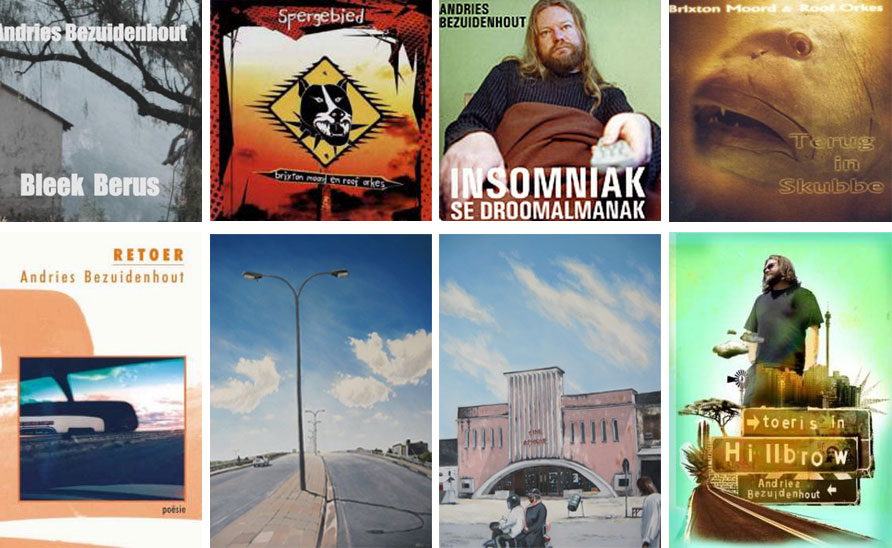Visual art, poetry and music by South African artist
Andries Bezuidenhout
As visual artist, Andries mostly produces oil paintings of South African and other African landscapes. He explores the radical potential of landscape painting, seen as a conservative genre, in times of environmental degradation and rampant social inequality. His paintings depict cities, mining towns and South Africa’s rural hinterlands. He lives in the historical town of eDikeni (Alice) in South Africa’s Eastern Cape Province and cites artists such as Moses Tladi, Walter Meyer and Vilhelm Hammershøi as influences.
As Afrikaans speaking poet and musician Andries explores matters of identity and belonging against the backdrop of changing South African landscapes. His work, as Lloyd Gedye writes, is “fascinated with the idea of white people finding peace in the new South Africa, reconciling their troubled history and positioning themselves within the social fabric of South Africa — and the bleak dry landscape is the perfect metaphor for that history. While friends emigrate and others live in fear, Bezuidenhout is looking forward — too much a part of this country to quit…” Fred de Vries describes Andries’s songs as having “a bleak, almost tinny sound… that tell tales of leaving, murder and ecological disaster. Discomforting tunes for an uncertain age, but always with a touch of humour.”
Andries is a member of the rock band Brixton Moord en Roof Orkes (“Brixton Murder and Robbery Band”), but also performs as solo artist in the singer-songwriter genre.
He teaches development studies at the University of Fort Hare in South Africa’s Eastern Cape Province.
Latest music video – “Lukas Impossible”, Afrikaans and English versions of the same song.
News:
Two new albums were released on 5 July 2024 – one in English, titled No place for time here, and one in Afrikaans, titled Trooskantates.
From the media:
“For me Andries is one of the most exciting and versatile characters in the alternative Afrikaans scene.” -Fred de Vries, LitNet.
“He may describe himself as a mere ‘blip’ on the Afrikaans cultural scene but Andries Bezuidenhout’s new album Bleek Berus positions him as one of the country’s most significant songwriters.” -Lloyd Gedye, Mail & Guardian.
“Bezuidenhout is Afrikaanse rock se gewete.” – Dirk Jordaan, Beeld.
Poetry and journalism:
Retoer (2007, Protea Boekhuis) – poetry
Toeris in Hillbrow (2010, Human and Rossouw) – newspaper columns
Veelvuldige gebruike vir huishoudelike toestelle (2014, Protea Boekhuis) – poetry
Albums:
With the Brixton Moord en Roof Orkes, Spergebied (2002, Rhythm Records), Terug in Skubbe (2004, Rhythm Records), Slaaptyd in die Suburbs (2015, Independent), Bazaar Punk (2022, Dikeni Records), and Strate sonder bome (2023, Dikeni Records).
As solo artist, Insomniak se Droomalmanak (2003, Rhythm Records), Bleek Berus (2009, One-F Music), Onplaats (2020, Die Wasgoedlyn), Spoorlangs (2021, Dikeni Records), Dink aan planete (2022, Dikeni Records), No place for time here (2024, Dikeni Records), and Trooskantates (2024, Dikeni Records).
Andries produced and recorded an Afrikaans spoken word album with Valda Jansen, Mercy Kannemeyer, Salvia Ockhuis and Lydia Gittens, released as Derde golf (2021, Jakes Gerwel Foundation and PEN Afrikaans).
Academic books:
Grounding Globalization: Labour in the Age of Insecurity, by Edward Webster, Rob Lambert and Andries Bezuidenhout (2008, Wiley-Blackwell). Winner of the 2009 Distinguished Scholarly Monograph Prize, awarded by the American Sociological Association Labour and Labour Movements section.
Labour Beyond Cosatu: Mapping the rupture in South Africa’s labour landscape, edited by Andries Bezuidenhout and Malehoko Tshoaedi (2017, Wits University Press).
Critical Engagement with Public Sociology: A Perspective from the Global South, edited by Andries Bezuidenhout, Sonwabile Mnwana and Karl von Holdt (2022, Bristol University Press).
Labour Disrupted: Reflections on the future of work in South Africa, edited by Malehoko Tshoaedi, Christine Bischoff and Andries Bezuidenhout (2023, Wits University Press). More details at Google Scholar.
Details of available works of art here.

